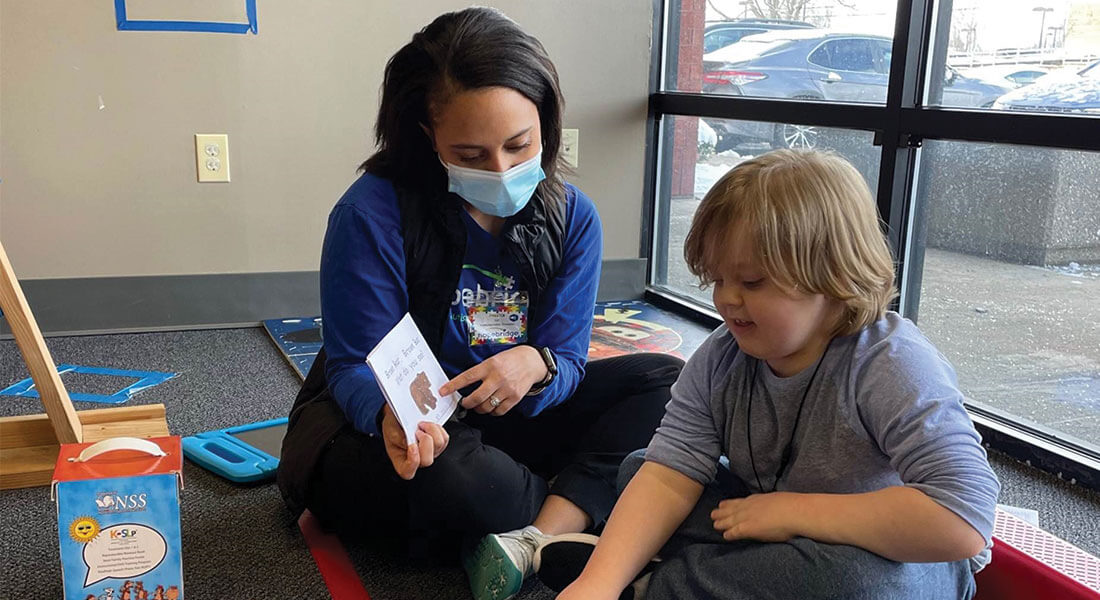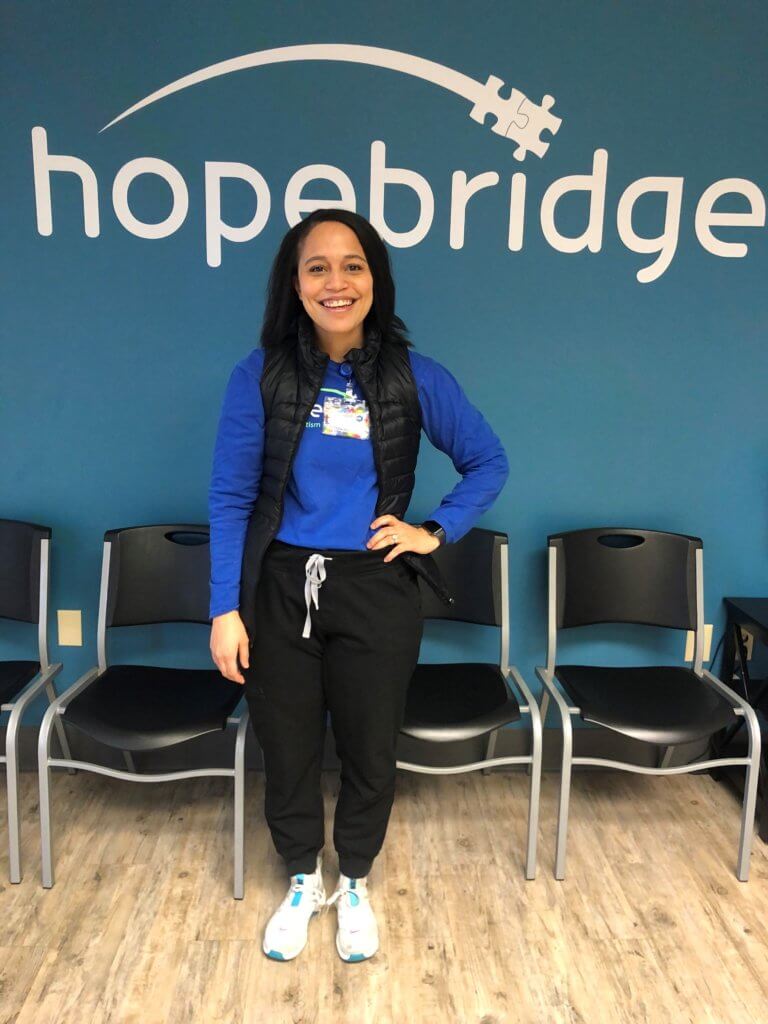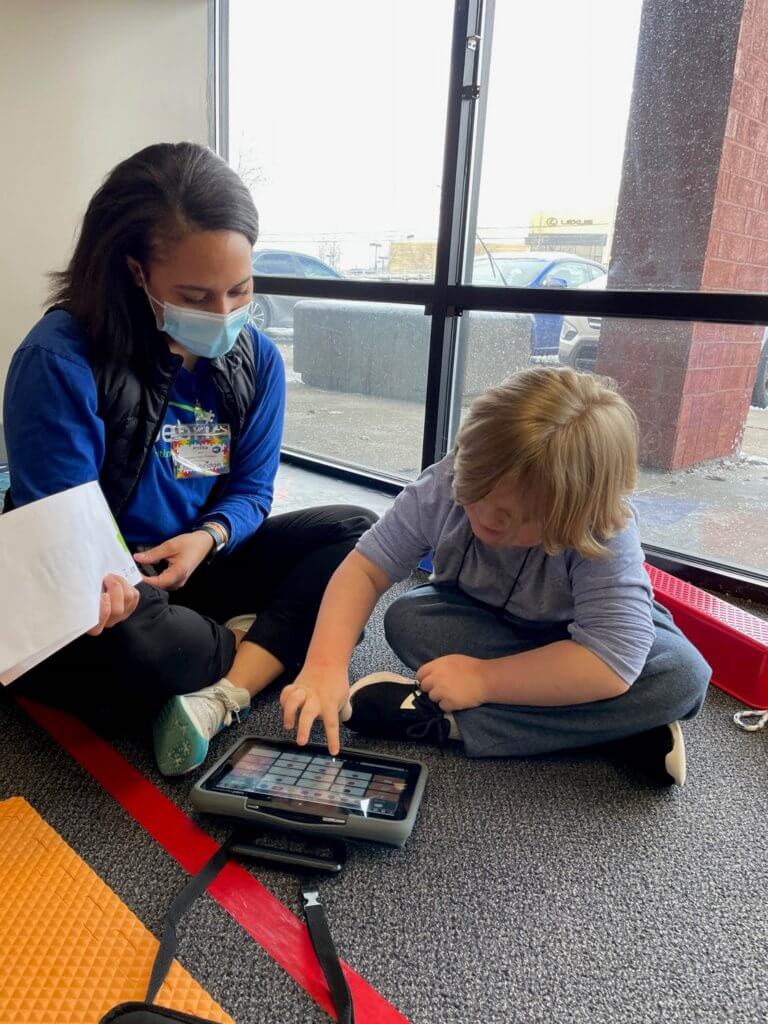Developing Language and Communication Skills for Kids with Autism While Social Distancing
February 18, 2021
February 18, 2021

Sheltering at home, quarantining, social distancing and mask-wearing were new concepts to almost everyone on Earth until about a year ago. Adults continue to cope with them – physically, mentally and emotionally – so it should come as no surprise that this struggle is multiplied for children. Now factor in communication and behavioral challenges such as speech delays and autism spectrum disorder (ASD) … how can a young person experiencing these continue to build their skills at such a crucial developmental age?
Through our interdisciplinary autism therapy programs, we have continued to help children develop their language and social skills, both in the center through one-on-one therapy, as well as via telehealth sessions. Hopebridge Speech-Language Pathologist (SLP) Jessica Bosley from our Lexington, Kentucky center is one of our in-house heroes who managed to shift gears and adapt to the new world around us, all while keeping up the progress with her kiddos. We recently connected with Jessica to guide caregivers through this process and enable them with recommendations to enhance communication opportunities at home.

Children with communication deficits have challenges with social communication within a typical year. Adding masks and physical distance expectations this past year has made language development even more difficult for this population. Social situations can be tough for them even on a perfect day, so these new elements add yet another layer.
As parents and therapists, we now have the unique opportunity to make this environment as structured and beneficial as we can for our children. I became a parent last summer, so I know first-hand that it is easy to get caught up in our days, but there are so many chances for us to put a positive twist on the current situation.
To do that, here are some tips and takeaways from speech therapy within our centers that families can incorporate into their own daily lives to continue developing communication and social skills with their children at home.
Beyond the tips that I shared for drawing out language, there are a few tools and games I used during virtual therapy or here at the center that work well and easily carry over for parents at home.
Even during speech therapy, movement is important! Anything that gets the body in motion will elicit language. I love the freeze dance. If your child has a wiggly body, this is a great opportunity to get them to move around and then incorporate words like “stop,” “go,” “up” and “down.” YouTube has workout videos for kids, but if you’re a Peloton family like we are, check out the “Fit Family” classes that are fun for kids and adults. Taking a walk also promotes communication opportunities.
Some of my favorite teletherapy activities are show-and-tell and scavenger hunts, and they can work well at home. Say something like, “Go into your room and find something that is red.” The child is hearing that receptive language piece and has to follow directions to find something and bring it back. If they are able, encourage them to talk to you, too. Bonus: it incorporates movement again!
All of these games can be used to develop language, but my go-to within therapy is using literacy and books. It is easy to create a theme around books and they keep children engaged, plus, early literacy skills are incredibly important. The most effective books I’ve found are repetitive stories because they are predictable. They decrease the cognitive demand needed for comprehension, as well as increase engagement and language, which allows them to focus on the book. Brown Bear, Brown Bear is a great one that kids pick up on quickly because the language repeats over and over and builds upon itself. Five Little Monkeys, Chicka Chicka Boom Boom and Pete the Cat books are also good choices. These books create a welcoming environment for children to show off what they know and may otherwise have a tough time paying attention or have cognitive challenges. Lead them in with a phrase and let them fill it in to give them the chance to be independent.
Feel free to use what you have within your home. Toys, blocks, mirrors, boxes, shaving cream, plastic cups—the list of options is never-ending. Anything that can be built, filled or played with can lead to communication, so there is no need to get more toys. Create language opportunities within whatever they are interested in playing with or doing because it will be more motivating for them.

At Hopebridge, we provide medically necessary therapy for many children with autism and other developmental delays. In tandem with the COVID-safe procedures we have in place, we are able to provide a space and services that allow us to work with children to provide and strengthen language and social opportunities.
One thing that sets us apart from schools and many other therapy options is that every child has an adult with them at all times. This enables us to create social environments in which we can constantly monitor for safety. Our team members are actively engaged in therapy but are also standing by to sanitize, distance, separate and teach social behaviors, such as to cover their mouths when sneezing or coughing, throughout these interactions. Always having an adult nearby makes a world of difference.
Another benefit of our multidisciplinary autism services at Hopebridge is the collaboration within our centers. Our behavior analysts, occupational therapists and speech therapists work together to create and send information and materials home to implement, then get feedback from parents as to whether they are working.
Parent training is another key element of Hopebridge’s personalized programs. During the pandemic, we moved to holding trainings via Zoom so families do not need to come inside the clinic. This is another perk of technology that we may not have used prior to the coronavirus.
While they are not used by every child, the implementation of effective and functional Augmentative and Alternative Communication (AAC) devices is something that has become increasingly important to us at Hopebridge since the beginning of the pandemic. Options include sign language, Picture Exchange Communication System (PECS), pre-programmed buttons and high-tech AAC devices. If a child is nonverbal or struggles with verbal communication, we work to not only find a proper device that meets their needs, but also that the vocabulary is appropriate for their communication level and within their home setting. For instance, if a family eats spaghetti every Thursday night or the family dog is really important, we want them to be able to communicate that. This is more significant now than ever.
As a speech pathologist, the act of wearing masks has completely changed how I approach articulation therapy and language therapy. Even the imitation piece is now missing the visual element. To do this effectively yet safely, I’ve begun using videos of myself or using picture cards to show how the sound looks. Then, I show my kids their own face in a mirror or place them in front of an iPad camera so they can see themselves. They now use their own faces for modeling and feedback whereas before, we were dependent upon them looking at me and my mouth. Instead of solely feeling it, they’re seeing it. This has created more independence and immediate reinforcement. As a clinician, it’s been a game-changer, and I have already witnessed one child who exploded in their speech sound production, in part thanks to this new tactic.
In addition to sharing her tips for parents and providing an insider’s look at how we approach this within the centers, Jessica also wants to remind families to notice the flexibility in kids.
“This time has allowed us to view the flexibility of people, especially within the autism community. These kids have had to adapt and learn boundaries with masks and social distancing. They are growing and changing with the times,” Jessica told us. “While the reason and process was unwanted, of course, it has been a surprising perk to realize how much growth people can have under pressure.”
If developing language and communication skills is a concern for your child, don’t hesitate to contact us. Hopebridge combines complementary services like speech therapy, occupational therapy and applied behavior analysis (ABA therapy) to help children with autism reach their greatest potentials. To find out more or arrange an evaluation at one of our centers across the country, please fill out our easy online form.
*Informed consent was obtained from the participants in this article. This information should not be captured and reused without express permission from Hopebridge, LLC. Testimonials are solicited as part of an open casting call process for testimonials from former client caregivers. Hopebridge does not permit clinical employees to solicit or use testimonials about therapeutic services received from current clients (Ethics Code for Behavior Analysts 5.07-5.08; BACB, 2020). Hopebridge does not provide any incentives, compensation, or renumeration for testimonials provided by a former client or client caregiver.
Autism Therapy
May 17, 2023
New BCBA Career Pathway Program Promotes Ongoing Skill Acquisition and Leadership Opportunities